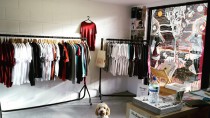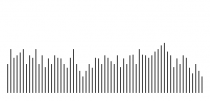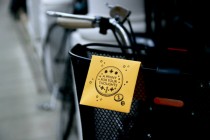Recently I’ve been having some of those passing yet re-occurring thoughts that often lead me to think it might be worth forming them into something more concrete such as an opinion… The opportunity to do this has presented itself nicely with central stations ‘sound’ month as it has mainly been around this subject that I have been pondering.
I took a well-trodden path from making music to getting interested in production and eventually studying sound engineering. I now run a sound studio based at Southside Studios where I work with sound in a variety of contexts including music mastering and post-production. For the purposes of this blog post however I intent to concentrate specifically on sound design or more accurately sound as a design discipline.
In classifying designed sound as the product of a distinct discipline I feel it is necessary to distinguish it from other forms of sonic creativity, not to form any kind of hierarchy but in order to clearly define it. I’m sure that many of the areas such as experimental music and sound art will, and have been covered by other bloggers and although I am interested and influenced by these areas, I want to concentrate on the use of sound in conjuncture with visuals and especially in new areas of digital media. I also seek to define sound design as distinct from composition for picture, although the two are often inextricably linked and interdependent. There are of course well-established discussions around traditional sound design, in the Hollywood tradition, but unless we are very lucky most of us will never work on big budget films.
It is perhaps often working to picture, which places me in the position of needing to define my work, and also what has lead me to have the aforementioned re-occurring thoughts. In my experience, the creation of content, which includes both sound and visuals, is a process fraught with misunderstanding even though the final product usually seems to function symbiotically. The subservience of sound to picture is, I feel, intrinsic in this. I’m sure that there are many people who feel sound and image should be treated equally. Viewed as a discipline or skill/job, I agree, but in the context of a piece of content and in the creative process I think that Image has the upper hand. It is the image that conveys the vast majority of the information and also importantly sets the stylistic tone of the work. Again I don’t wish to place one above the other but I feel that there is reluctance amongst those who work with sound (myself included) to accept this. That is not to say that there are not areas where picture is subservient to sound but in my opinion these are concentrated around music. To clarify: a piece of sound design has little meaning without the where as a piece of music functions perfectly well without a music video.
Where sound does have the upper hand however is in conveying and creating emotion. Music of course does this extremely effectively but the power of well-chosen effects, a varied dynamic and a sonic theme can subtly influence on a level of consciousness where even music fails. This is of course extremely well documented and is at the core of all sound design work. Where I think the discussion is lacking and what could also ease some of the difficulties in cooperating with people creating visual content is the development of sound design as just that. Design.
I tend to find that sound is viewed by people both from the inside and outside as somewhat mystical. Strange pallid people sitting in odd shaped` rooms pressing glowing buttons. It was this which initially attracted me to the job but since I’ve become one of those strange people and I know what the buttons do, I’ve been increasingly interested in the comparison of sound design to other design disciplines and how, if at all, they relate. I often work with people who work with graphic design, animation, motion graphics etc and also, (due to the location of my studio), have frequent discourse with interior/furniture designers and product designers. One important point that I find reoccurs is the need to develop a personal style, a set of creative devices and tools, which can be modified and refined to suit each project or context. This is not confined to the production of work but also to the development of a designer’s career.
This naturally leads me to question how this relates to designing sound. Is this something I concentrate on? Is it necessary in the development of me as a designer?
What part of my practice could I apply this too? Due to the aforementioned subtlety of sound it is often difficult to accurately define what you wish to achieve. The process however, of designing a sound or sound track is very similar to any design process. An idea is refined and adjusted until there is an inexplicable sense that it meets all requirements both aesthetic and functional. In sound design it is often the latter, which prevails as a viewer generally has a preconceived idea of what something should sound like. It is almost a cliché that sound designers present an idea, which after being rejected and replaced several times is finally settled upon as having worked fine in the first place. I often describe working with sound as like shepherding both the sound and client to a place where everything works well and doing it as efficiently as possible.
Where, however, does an aesthetic fingerprint or style fit in? Of course as with any Individual the brain is likely to come up with similar ideas, which can, after repetition, become a style but how does one recognise this repetition and refine it to remove the inevitable bad aspects of it? This of course is a process of scrutiny, which anyone wishing to develop creatively must undergo but I feel that it is often neglected in the discussions surrounding sound in favour of perpetuating the mystical nature of the work and a preoccupation with the tools of the trade. Traditionally sound has been a reasonable exclusive career path due mainly to the cost and complication of the equipment and to an extent this still holds true. But as technology develops and more people have access to the tools they need I think that the need to treat sound in a similar way to visual design is greater. With the constant expansion of digital media the development sound sometimes feels like it lags behind slightly. The evolution of procedural audio and the need to transfer an aesthetic used in linear sound design to a non-linear environment sometimes seems stilted. Perhaps the best method of introducing new ways of thinking about sound is to work extremely experimentally and explore all the more far out possibilities as sound artists and experimental musicians do. As much as this is utterly necessary and often responsible for pushing the boundaries of creativity and technology, there is often little room or time for this type of experimenting in a commercial sound design context. I don’t think it entirely inappropriate to make an analogy with the difference between visual artists and visual designers, with the latter working intentionally to purpose.
I do not claim to be able to answer the questions I pose but as Brian discussed in mix-blog #1 sound has an enormous impact on our environment yet is often undervalued. There needs to be a move towards regarding sound designers (as they are in a traditional film environment) as being a separate entity from musicians and composers and as an integral part of a design process to be brought in from the beginning of a project. One of the advantages of working with sound design is that the skills are, (once the tools have been learnt), generally transferable to a wide variety of media. This allows for the flexibility to work in many different fields but still leaves room for personal style. I feel that an emphasis on development of this personal style that is known and trusted should be what anyone working in sound design is trying to achieve. But knowing sound this is easier said than done and if anyone has had any luck please let me know how! Anyway, it will all probably sound shit in the morning…
/////
Mix-Blog: A bit like a mix-tape but with blogs instead. Read more from the series here.














Comments